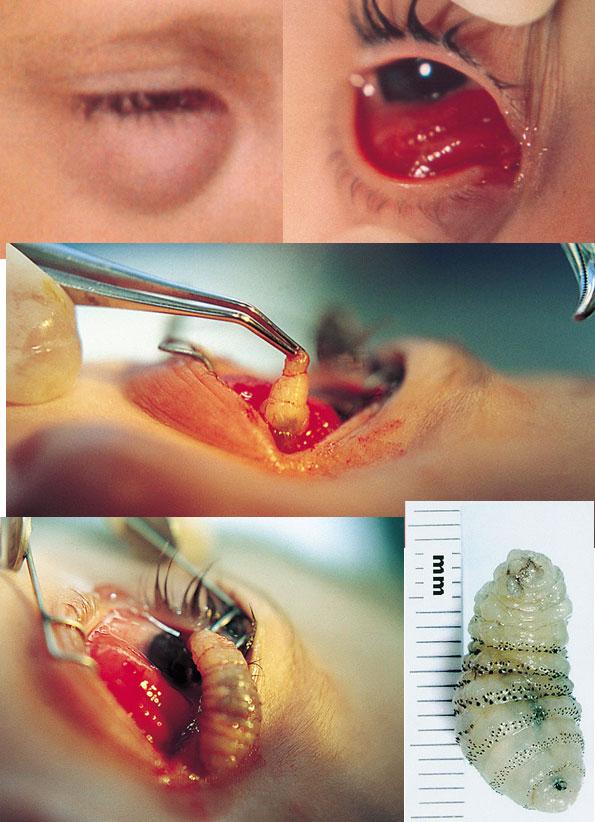Claim: The larva of a human botfly was removed from a child's eye.
Example: [Collected on the Internet, 2002]
Subject: Fw: Careful with dust!!!
|
Origins: Tales of insects; living and growing and nesting inside the human body prompt some of the most visceral responses of all the types of horror legends. We can read about people being killed in all sorts of gruesome ways almost with equanimity, it seems, but the thought of creepy-crawlies inside our bodies sends shivers up and down our spines. (Just think how repulsed most people are by the sight of maggots, even when they're feeding on flesh that's already
dead.)
And if bugs are going to turn our own corporeal residences into homes for themselves, they could scarcely choose a more revulsion-inducing site than an eyeball — the location of the most important and vulnerable of our senses.
Chilling as they are, the photos accompanying this item, at least, are real. They were taken from a July 2000 article appearing in the Archives of Ophthalmology (a journal published the American Medical Association) that describes and illustrates the removal of a human botfly larva from the eye of a 5-year-old by in Honduras by an Air Force mobile ophthalmic surgical team. As summarized by the article:
A 5-year-old boy with inferior orbital swelling and an erythematous mass arising from the inferior cul-de-sac of his right eye was seen by an Air Force Mobile Ophthalmic Surgical Team working in a rural area of the Republic of Honduras. The respiratory pore of a late-stage larva of the human botfly (Dermatobia hominis) was located in the anterior orbit. The larva was gently removed under general anesthesia through a small incision in the conjunctiva
Botflies (such as the one featured in these photos, the human botfly, or Dermatobia hominis, commonly found from central Mexico through to Central America and South America) are one of a number of insect species that lay their eggs on the exterior of other living creatures (usually mosquitoes or flies); when the eggs hatch, the larvae burrow into their "hosts" to feed (breathing through the small burrow holes) until they emerge to pupate into mature adult botflies.
Generally, a female botfly's choosing a human host for her young poses no great threat to the human, and the infestation can be eliminated via a simple surgical procedure, as the cited article notes:
Covering a larva's burrow hole with some type of ointment or fatty substance will generally remedy the problem; if not, a simple surgical procedure
Also, as noted in the article, a botfly in the eye is far from a common occurrence, "no previous case to our knowledge of orbital invasion hav[ing] been reported."
Although the implication that some have taken from the Internet text accompanying this message — that getting "bad dust" in one's eye and rubbing the eye might somehow cause the type of problem shown here — is wrong, the gist of the message is correct: one should not dismiss a persistent swelling and itching of the eye as merely "I've got something in the eye"; it should be checked by a doctor as soon as possible.
Additional information:
| | Anterior Orbital Myiasis Caused by Human Botfly (Archives of Ophthalmology) |
Last updated: 1 November 2006
 Sources:
Sources:

